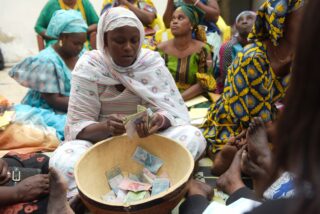You know the saying, “Money makes the world go round”? Replace “money” with credit, and it will be just as valid. The entire financial space relies on credit. While you read this, there’s a cash-strapped shopper somewhere in the world paying for groceries with a credit card. And a family is locking in a mortgage for their dream home somewhere else. There’s a business borrowing to stock up on supplies. Even governments are borrowing to make their budgets work. As of 2023, the world’s debt hit a record $307 trillion, marking what countries, families, and businesses borrowed altogether.
However, credit is a luxury in Africa. Most (82.6%) formal Micro, Small and Medium Enterprises (MSMEs) in Africa have unmet financing needs. The ratio of credit to GDP is only 18% in sub-Saharan Africa. Meanwhile, comparable figures in South Asia and Latin America are 37% and 47%, respectively. SSA also lags behind other regions in access to finance, with only 19.9% of firms having a bank loan or line of credit in 2020. In Nigeria, 70% of bank account holders still struggle to access formal credit. Yet, the credit demand is through the roofs.
There are several reasons for this deficit. For instance, Morocco (71%), Egypt (67%), and Nigeria (60%) rank among the top seven countries globally with the highest unbanked population. It’s a continent-wide problem: Africa is home to over 350 million people who have never had a bank account. That already excludes a chunk of the population from accessing credit.
But even with a bank account, getting a bank loan in Africa isn’t the most inclusive experience for everyone. There’s the usual slow application with lots of paperwork. And then, banks have a checklist that leaves people out – a steady income, a minimum volume of inflows through your account, and an amount that stays in your account. Most of these requirements are out of reach for the average African.
Too technical for fintech?
Over the past few years, fintech startups have tapped into Africa’s appetite for credit. Neobanks have flooded App stores with quick credit offerings that don’t discriminate. This report by Google and Appsflyer shows that finance apps, including lending apps, spiked by 25% last year alone. Also, Google searches related to lending dominated from May 2021 to May 2022. These apps remove the barriers of cumbersome paperwork and slow approval from banks.
But this story hasn’t been a fairytale. Tech hasn’t exactly figured out mutually beneficial models to solve Africa’s credit problem. That’s why borrowers getting money from some of these apps run into sketchy loan terms — like crazy-high interest rates or lenders calling their phone contacts to hustle repayments. Lenders who choose to be ethical don’t have it easy either. Many of them struggle to turn in profits and evade bad loans.
For instance, in the fiscal year ending June 30, 2022, TymeBank reported a net loss of R976 million ($57.5 million). However, by the close of fiscal 2023, its losses fell by 20.7% to R858 million ($45.6 million). Its December 2023 result was primarily driven by significant growth in net interest income and fees and commission incomes, which rose by 109% and 360%, respectively, reaching $28.2 million and $18 million from fiscal 2022. This robust performance contributed to TymeBank’s top-line revenue, which surged by 62% to $48.5 million in fiscal 2023.
However, TymeBank’s revenue growth didn’t come without a cost. TymeBank’s credit impairment charge, representing loans that customers couldn’t repay or deemed as bad loans, saw a substantial increase. This charge, a modest $65,000 in 2022, dramatically surged by 20,000% to $13 million in 2023, impacting Tymebank’s net revenues, which settled at $35.5 million.
FairMoney is another notable example. It turned a profit in 2021 with a net income of N1.6 billion ($3.9 million). But by the end of 2022, it had incurred N3.73 billion ($8.3 million) in losses as bad loans surged by 138% to $101 million.
Community-led credit wins
Africans have used informal community-led systems to provide credit for themselves for many years. Whether it’s the East African Chamas, West African Susu (Esusu) or South African Stokvels, people have driven their financial growth by themselves. And some of them have grown from casual savings pools to full-fledged investment clubs.
Milele Alliance in Kenya is a good example. In 2007, ten women pooled their resources, saving $185 monthly (Ksh 30,000). They met every third Saturday for eight months, set goals, crafted a constitution, and registered as a company. A year later, with a banking partner, they bought a residential property, growing their portfolio to over $215,384 (Ksh 35 million) in 2020.
Many other Africans now use Facebook, WhatsApp and Telegram communities to create savings and credit pools. So, even though tech startups might be having a hard time closing this credit gap, Africans are now using tech to make their age-long credit practices more efficient.
The lesson here is that Africa’s credit problem might only be considered “stubborn” because we are trying methods that aren’t optimised for low-trust environments. Community-led systems run primarily on trust, and that’s why they have lasted this long.








